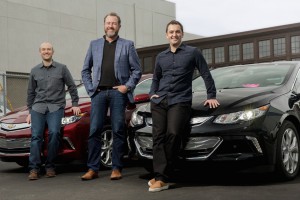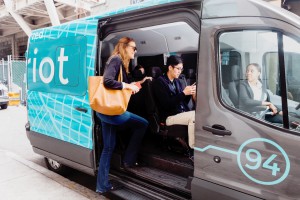
Lyft founders Logan Green, left, and John Zimmer, right, shown with GM President Dan Ammann after inking a $500 million partnership last year.
The need to sink money into new mobility ventures is likely to place a heavy burden on the cash reserves of established automakers, one of the auto industry’s top strategists told the Center for Automotive Research’s annual briefing seminar in northern Michigan.
Al Koch, vice chairman at the global business-advisory firm AlixPartners, said automakers are already seeing their capital-spending levels average nearly half of available cash per year.
However, they about to be hit with an incremental increase in spending for revolutionizing the automotive industry today. This could potentially strain the industry’s cash reserves in ways not seen since the Great Recession, and should prompt companies throughout the industry to focus on return on invested capital, Koch said.
“The industry endured a lot of pain back in those dark days, but a lot of financial discipline has ensued. However, the real test will be whether the industry can maintain its financial discipline in the face of the needed incremental spending for the conversion to new mobility coupled with what certainly looks to be a cyclical industry downturn,” Koch said.
(Automakers do about face on CAFE standards. Click Here for the story.)
Koch, who has more than four decades of experience in the auto and other major industries, used his experience in evaluating companies’ business models and balance sheets in his speech, “Rewired for Success—Is the Industry Sustainable Going Forward?”
Sustained success will likely come only if companies in the industry focus on their return on capital, not just profitability or sales.

Automakers will spend billions in the near future on mobility ventures, like Ford's Chariot shuttle service.
Improving ROIC while at the same time paying for new-mobility programs will likely require such things as “asset-light” business models and partnerships get beyond the industry’s not-invented-here syndrome.
The industry’s “ongoing” capital requirements historically equal about 10% of a company’s sales such as for maintenance, research and development and “cycle-related” requirements to weather a cyclical industry downturn that many see approaching.
The AlixPartners analysis, however, showed that capital spending by the world’s top 20 automakers increased by an average of $12 billion last year, equal on average to more than 47% of available cash at those companies.
The numbers are about to rise significantly, he said, as the race to new mobility takes a quantum leap in the next few years in terms of the need for funding, he said.
Overall, he estimated that the auto industry will have a bill awaiting it of “several incremental billions” in costs related to what Alix’s analysts describe as CASE or the connected, autonomous, shared and electric vehicles of the not-too-distant. The new obligations will potentially start coming due almost immediately, and could really take off around 2020.
(Click Here for details about Nissan’s rear door alert.)
In his speech, Koch noted that the auto industry will also be facing fierce competition from the technology industry in the race to new mobility.
AlixPartners’ research indicates there are now more than 50 “big-name” companies working on autonomous vehicles or autonomous-vehicle systems, along with dozens more smaller companies and start-ups.
At the same time, the ROIC in auto industry pales in comparison with that in the technology industry which, he said, greatly aids the tech industry’s competitiveness, including giving it options for cheaper capital-raising.
Last year in the information-services sector of tech sector, the ROIC averaged 36%, in computer services it averaged 30%, and in computers and peripherals it averaged 24%, while automakers’ ROIC averaged just 6%.
The “ROIC considerations” companies should make when strategizing their place in the new-mobility landscape come down to what he called choosing among the “3 P’s:” “participate,” as in adopt a go-it-alone strategy; “partner,” as in team up in some fashion with other players; or “purchase,” as in acquire tech companies or pieces of them, he added.
“Efficient use of capital suggests that the industry keep ROIC in the forefront, including developing ‘asset-light’ approaches to everything from products to plants to partnerships,” said Koch.
“In a low-growth, capital-intensive industry like auto, that’s the only way to ensure success, especially when you now also need to compete with the high-growth, historically low-capital-intensive technology industry.”
(To see more about Tesla’s latest financial results and what they mean, Click Here.)
Koch said companies that don’t focus on the cost of capital risk falling into a vicious cycle of low shareholder returns, higher costs of capital and, eventually, becoming irrelevant in tomorrow’s new automotive ecosystem.”
